If you have a sailboat, sooner or later someone’s going to have to go up the mast. Maybe to check the rigging, maybe to fix something, or maybe to install new gear.
The traditional way is to use a bosun’s chair: basically a “chair” made of a plank and fabric sides that attaches to the main halyard. Then the lucky person on deck gets to crank a winch and haul the person in the chair up.
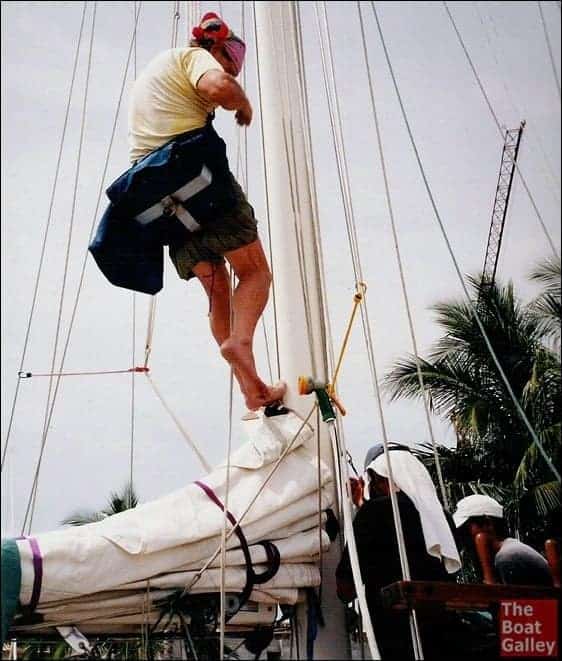
The photo above was from our first trip up the mast on our first boat, Que Tal. These guys were doing some work on our boat and didn’t have too much trouble winching Dave up, trading off every few minutes. For me to haul him up was a different story. We had to run the halyard all the way back to our two-speed jib winches and it was very slow going, especially as I had to also periodically take up on the spinnaker halyard that was attached to a climbing harness as a safety backup. (NOTE: on future trips, we also learned to tie ourselves to the mast so we couldn’t swing.)
When we were looking at Gemini catamarans prior to buying Barefoot Gal, we had the opportunity to buy a “Mast Mate.” To be honest, we only sort of knew what it was (the guy selling it had given us a lot of help but wouldn’t take payment, but did have this gizmo to sell as it was too short for his boat . . . ). The guy selling it told us he’d used it on a Gemini and it was like having a ladder up the mast – he loved it.
A Better Way Up the Mast
To us, the Mast Mate is a huge improvement on a traditional bosun’s chair. It is made of very heavy webbing with loop steps on each side for the person going aloft. The top attaches to the main halyard and there are slugs that go in the sail track to keep it right at the mast. There is also an optional “belt” that can go around the person and the mast – and it has pockets for tools and parts.
We use a bosun’s chair in addition on the topping lift (you could also use a spinnaker halyard) both as a safety measure and so that the person aloft can sit to work at the top of the mast – but the person on deck can just take up on it every three or four feet and cleat it off, which is easy since there’s no weight on it. The bosun’s chair is also a good resting spot halfway up the mast (a 40-foot mast is like climbing four sets of stairs to the fifth story of an office building).
Advantages:
- Much faster for the person to go to the top of the mast.
- Don’t need a gorilla cranking the winch on deck! We often hear people in the harbor asking for a couple of “strong guys” to help winch up a bosun’s chair so that repairs can be made at the mast top. We can do it with just the two of us (Dave is 78 and I’m 56 . . . )
- Could go aloft single-handedly (although wouldn’t have the safety of a second line)
The only disadvantage is that you have to take the main sail off the mast (you can leave it on the boom) to slide the slugs into the track on the mast. That literally takes less than minutes at the beginning and end of the operation – be sure to leave the sail ties on the sail so it doesn’t blow off the deck!
It’s easier to see it in pictures:
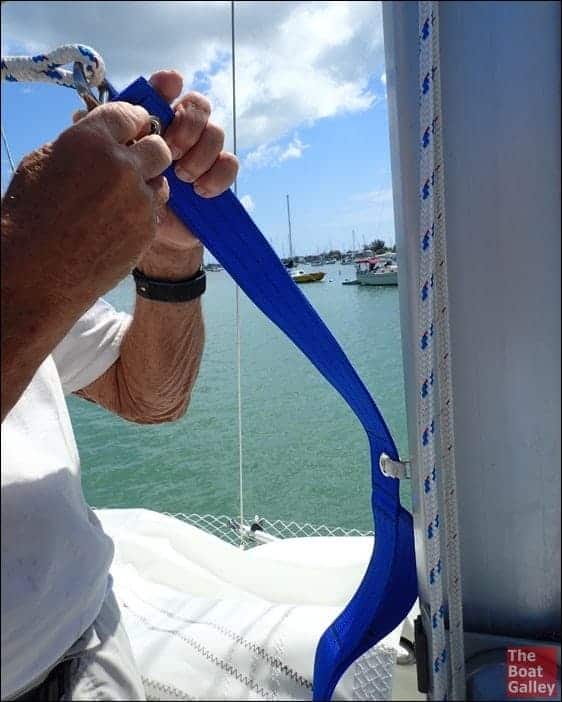
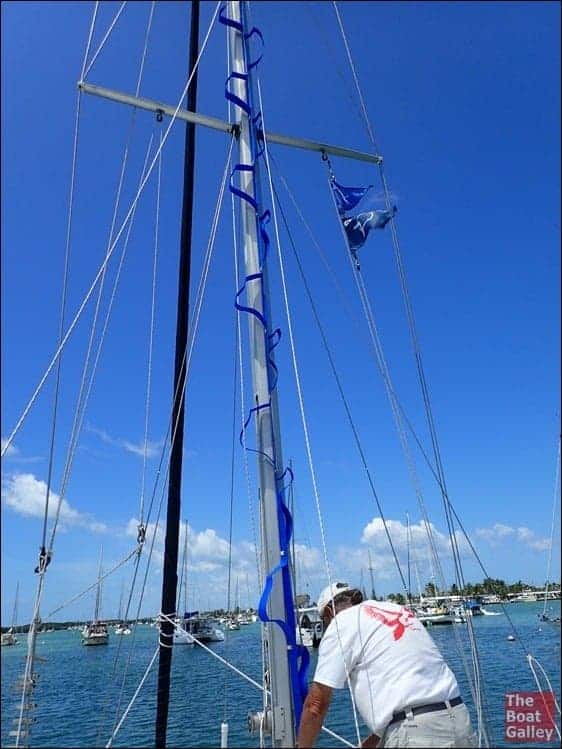
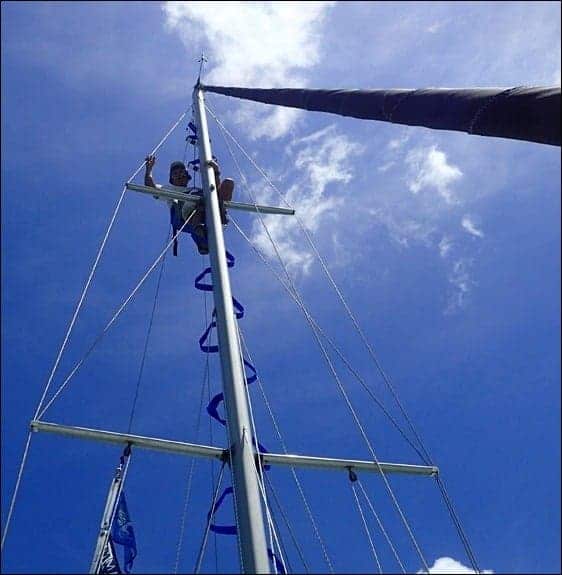
Going aloft may not be exactly fun, but we’ve found that the Mast Mate makes it much, much easier. We particularly like that it makes it feasible for us to do it without needing help from another boat – not that we’ve too proud to ask for help but so that if we have a problem in a remote spot, we can handle it ourselves. It simply makes us more self-sufficient.
You can only buy the Mast Mate directly from the company or if you happen to run across a used one. I will admit that they are not cheap, but it is a piece of gear that you are trusting your life to. We have had several inquiries about ours since Dave went up the mast last week – people saw just how much easier it was than the other boats nearby who were winching up bosun’s chairs the same day!
Here’s a video on the Mast Mate in use – below that are some tips on going aloft in general and specifically with the Mast Mate.
NOTES: There are some other mast climbing systems available, such as the ATN MastClimber. We have not used any others, but the ATN MastClimber looks to us to require greater physical fitness and flexibility.
Some people initially opt for a climbing harness to go up a mast. That may be okay for a very quick repair, but will quickly get uncomfortable. It makes a reasonable backup system for a bosun’s chair, however.
A climbing harness can also be a good backup to the Mast Mate, but it will not provide a comfortable perch to work from at the top of the mast (even the ones made for sailors). We find a bosun’s chair to be a lot better. We have a CrewLift by CrewSaver.
Tips on Going Aloft
- Think though what you need to do at the top of the mast and take all the tools you might need. Bosun’s chairs and the Mast Mate tool belt have big pockets for parts and tools – use them as you’ll want your hands free.
- It’s a good idea to take an empty ditty bag with a long line attached. If you find you need something more, you can lower the ditty bag to the person on deck and then pull it back up again.
- The Mast Mate is easiest to use with lightweight shoes or stiff-soled sandals (we wear our Keens). Boots are big to try to fit on the steps and bare feet will get sore quickly.
- It’s best (most say essential) to have two independent systems holding you aloft on separate halyards so that if one should fail (rare, but it happens) you won’t fall to the deck.
- Tie yourself to the mast so you won’t start swinging (obviously more important on a monohull than a catamaran). If it’s windy or wavy, it’s good to have two belts so that when you get to the spreaders you can put one above before removing the one below (and vice versa on the return trip). It’s a pain to do but a safety factor.
- If possible, choose a calm day.
- The person winching or tailing below should periodically cleat the halyards off so that if one slips, the person aloft can’t fall far (we aim for every 4 feet or so). Never have both halyards uncleated at the same time if someone is up the mast.
- If you are winching someone up in a bosun’s chair, be very careful not to get an override on the winch. If you do, tightly cleat off the backup halyard before unwrapping the override.
- Once the person aloft is at the level they need to be, the person below should move away from the mast so that if any tools or parts are dropped, they won’t be hit on the head. (This accounts for more accidents with someone going aloft than injuries to the person aloft.)
- If you have anchoring headphones, use them so you don’t have to yell back and forth and try to understand what the other person is saying. We have “My Team Talks” Bluetooth headsets and love them. Not only do they work well with no interference, they’re designed so that they don’t fall off . . . even on a windy day at the top of the mast.

Carolyn Shearlock has lived aboard full-time for 17 years, splitting her time between a Tayana 37 monohull and a Gemini 105 catamaran. She’s cruised over 14,000 miles, from Pacific Mexico and Central America to Florida and the Bahamas, gaining firsthand experience with the joys and challenges of life on the water.
Through The Boat Galley, Carolyn has helped thousands of people explore, prepare for, and enjoy life afloat. She shares her expertise as an instructor at Cruisers University, in leading boating publications, and through her bestselling book, The Boat Galley Cookbook. She is passionate about helping others embark on their liveaboard journey—making life on the water simpler, safer, and more enjoyable.
Your VHF can do so much! Learn how to use ALL its features for just $39:
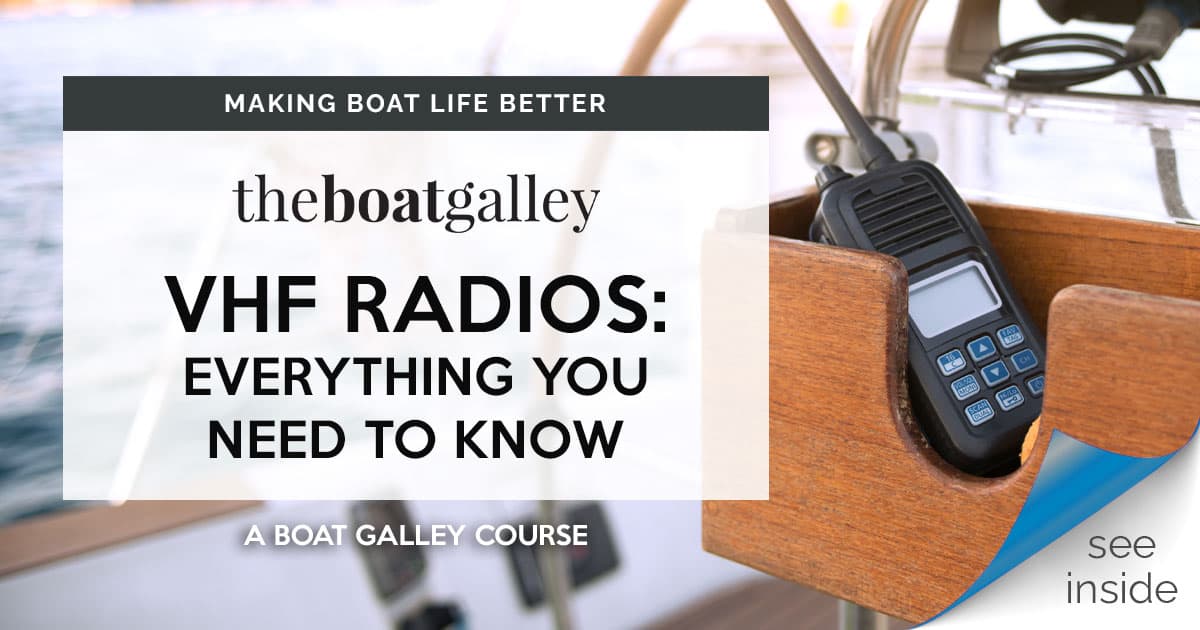
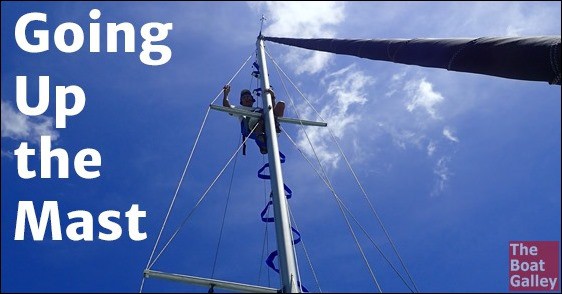







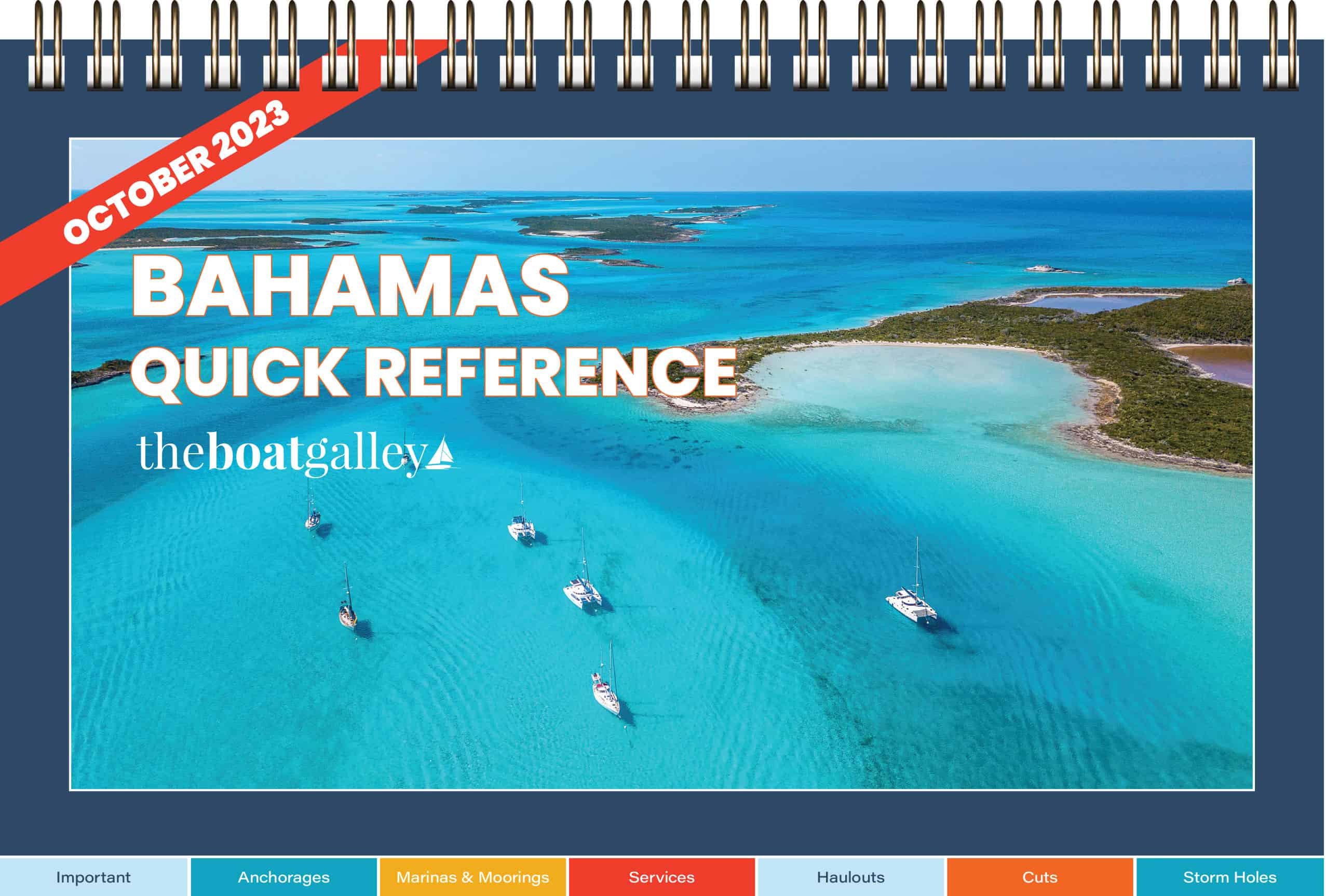

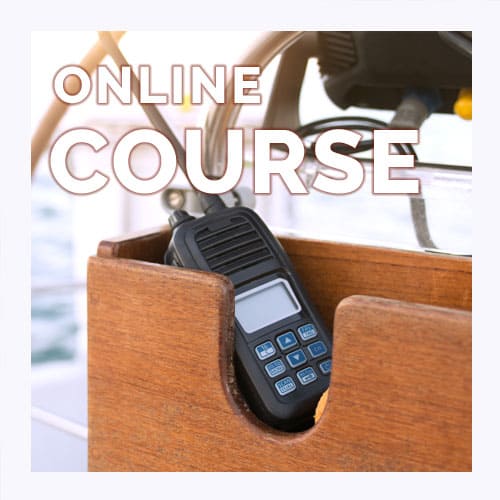
Brenda Greene says
We love our Mast Mate. I can’t do heights and I don’t want to be responsible for hauling my husband up in a bosun’s chair. Very sturdy. My dh is 250. He’s been up three times now.
Leo Corsetti says
I have one and I agree with you.
Bart Trish Masker says
Can it be used with an in mast furling?
The Boat Galley says
On the company website and on some forums, people say it can. Obviously don’t hook it in the track, but hoist on a halyard or topping lift and tie a line onto one of the lower steps. Put that line on a mast winch and tighten so the Mast Mate will stay next to the mast and be secure. We have not done that since we don’t have in mast furling, so I am not speaking from personal experience but it sounds like it would work.
Bart Trish Masker says
Thank you the The Boat Galley?
Philip Krueger says
I have in-mast furling (Hunter 340) and have used the Mast Mate that came with the boat. The slides don’t fit into the track so I have tried it as suggested, pulled tight. It still swings around when you put your weight on it and the give in the halyard makes it go slack once you put your weight on it. You need sturdy hard-soled shoes as the straps will make your feet sore.
I would really suggest getting slides that would fit into the “track” and/or using it as supplement to a bosun’s chair as Carolyn suggests.
Having gone up both ways I prefer the bosun.
Jackie Bartz says
We have a Top-Climber (www.topclimberinternational.nl/) that one person uses solo or a second person can “help” on the downward trip. I must say that it can be a little tricky to use the first time, especially if you’re un-coordinated, as I am, but I’ve been “to the top” many times using it.
I worked for a sail loft and my boss used one of these whenever he needed to go up a mast. He could go up faster than I could imagine. His advice was to have the halyard as tight as possible. That will help keeping the “lateral” movement to a minimum.
Basically it uses (mountain) climber “ascenders”. You control everything yourself. It is GREAT exercise, as well.
Jonathan says
We use a Milwaukee 24v right angle drill with a winch chuck adapter. The first mate takes me to the top in a couple minutes no sweat. Also used in the cockpit when we are too lazy to crank winches. ;-))
Mary Facker says
I looove my mast mate!
tami says
I don’t think this option would work for us. In our case, if we’d have to take the main off our catamaran, it’s less effort to grind Handsome Husband up the stick. (it’s a big main.)
We’re diggin’ ATN products, including the Mastclimber.
The ATN Mastclimber is a solo endeavour, needing only a tightly made halyard to climb on, and the watcher/second only needs to be there for safety and to tend the safety halyard (second halyard made to the climber). The Mastclimber has been all that Étienne Giroire (ATN) has described, http://www.atninc.com/atn-mastclimber-sailing-equipment.shtml
As for the MastMate, it does appear that you don’t actually HAVE to run the MM into the mast track. That said, I would doubt seriously that you can get enough tension on the webbing to have this thing be stable enough to climb easily and safely without the stability of running the slugs into the mast track. Maybe on a short mast you could get away with it
Amy D. says
Our solution is to cruise with teenage boys. They don’t weight much and love going up in a bosun’s chair! They would go up just for fun if we would let them.
Anonymous says
great timing…I had just watched this: https://www.youtube.com/watch?v=QUaYEhsgRpQ
Tom Thompson says
I used two pieces of Rock Climbing Gear to go up my mast by myself.
They are called an Ascender and a Gri Gri.
The Ascender is put on the halyard first. It grips the halyard with “teeth” that are at an angle. With the teeth at an angle you can push the Ascender up the halyard and the teeth prevent it from sliding back down. Part of the Ascender unit is a nylon loop long enough to dangle about a foot above your feet.
Next attach the Gri Gri to the halyard below the Ascender. The Gri Gri acts as a grip on the halyard when ascending and as a brake when descending.
With a Carabiener, attach your bosuns chair to the Gri Gri.
After attaching the Ascender and the Gri Gri, step into your bosuns chair.
Push the Ascender up so that the loop is about a foot off the deck. Pull UP on the halyard coming out of the Gri Gri to get the bosuns chair up high enough to sit in it. To help keep you from swinging around as you go up, you can put a nylon loop around the mast and attach the two ends to the bosuns chair.
To go up the mast; as you are sitting in the bosuns chair, push the Ascender up the halyard as far as you can. Next, grab hold of the Ascender and STAND up in the nylon loop that is dangling from the Ascender. When doing this move there is no weight in the bosuns chair. Next, pull UP on the halyard coming out of the Gri Gri as far as you can and the bosuns chair will rise up for you to sit in it. As you sit in the bosuns chair, PUSH the Ascender up the halyard again.
By repeating the process of pushing up the Ascender and pulling up the Gri Gri and bosuns chair you can go up the mast in in increments equal to the distance you can push the Ascender up each time.
After getting up to do your repairs and you are ready to come down, disconnect the Ascender from the halyard and put it in a pocket on the bosuns chair. Hold the halyard tightly coming out of the bottom end of the Gri Gri and ease the lever on the Gri Gri allowing the Gri Gri to slide down the halyard.
There are several videos on YouTube that show the process clearly. Although you do not need anyone to help you with this technique it is nice to have someone nearby to help fetch tools you forgot to take up with you.
Tom Thompson
Theodore Gladden says
This sounds to be an ideal way to get up the mast solo, without another person help. I have a problem with the slugs used in the mast. I do not have a way to use slugs for I have a track guide and need a different way other than slugs. I would need track guides to slide up the mast and not slugs. Can this be made in place of the slugs?
Carolyn Shearlock says
You’d have to contact the company and see if they have a solution for you. They may very well have already encountered this question!